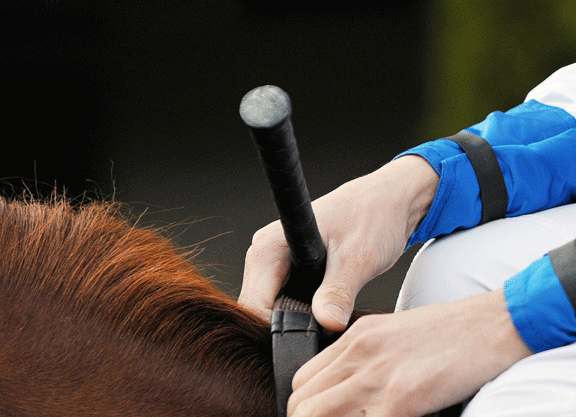The Week in Review, by T.D. Thornton
One of the ironies about the controversial topic of whip use in North American Thoroughbred racing is that the jockeys themselves apparently need to feel the sting of coercive correction to realize they have an opportunity to shape systemic change before it is imposed upon them.
The Apr. 5 letter (read it here) submitted by officials from The Jockeys' Guild to California stakeholders and regulators outlines an experiment in which riders at Santa Anita Park will race this Friday without carrying whips (or, as the Guild prefers to call them, “cushioned riding crops”).
The Apr. 12 trial is an admirable step in the right direction, and in the long run, it won't really matter if the Guild came to its decision to test out whip-free racing via the carrot (enticement) or the stick (punishment).
Either way, the willingness to engage in a no-whipping experiment does represent a marked departure from the set-in-its-ways testimony Guild officials gave to the California Horse Racing Board (CHRB) not even two weeks ago when the topic was discussed at length on Mar. 28.
At that meeting—prior to the CHRB unanimously advancing a potential rule change to bar in-race whip use for anything other than “when necessary to control the horse for the safety of the horse or rider”—Guild officials presented arguments about keeping the status quo that focused on the alleged “lack of any harm to the horse” and how “we as an industry did not put forth our best efforts in educating the general public” about how modern-day whips have “completely eliminated” welts and cuts to horses.
Those assertions were immediately challenged by CHRB members. Perhaps realizing after a week of reflection that the organization's attitude came across as tone-deaf in the midst of a cacophonous racehorse welfare crisis, the Guild subsequently offered to go whipless for one day per the letter of the law (CHRB Rule 1688). That rule, as currently written, does not actually require riders to carry a whip, but does mandate public disclosure for when a jockey won't be carrying one during a race. The Guild's letter served as advance notice that none of the Santa Anita jockeys will be using whips on Friday.
Guild co-chairmen Mike Smith and John Velazquez, who both signed the letter, won't be among the jockeys riding at Santa Anita that afternoon. Smith is booked on mounts at Oaklawn Park, while Velazquez will ride at Keeneland Race Course.
While it's generally considered wise, in any endeavor, to heed the experience of veteran, well-respected leaders and to present a unified stance, the Guild will be doing its membership a disservice if it doesn't also try to seek out and build consensus among riders who believe that it won't be the end of the world when (not if) whip use is barred on an industry-wide basis.
As CHRB commissioner Alex Solis, a Hall-of-Fame jockey, said after the Guild's Mar. 28 public comments, “I feel for my peers. But we're at a very critical time for horse racing here in California, and it breaks my heart. We're talking about the future of California racing, so I feel like we have to compromise one way or another.”
The banishment of whipping in our sport won't happen overnight. But here in North America, I'm betting on it being an industry-wide inevitability.
Given that premise, let's say you're an up-and-coming rider under the age of 25 who has aspirations of continuing on with a career in the saddle for the next quarter of a century. Professionally speaking, you're going to either have to adapt or expire. Do you want to have the chance to flourish under a new race-riding paradigm that is guided by your input, or do you want to cling to the outmoded current system that is well on its way to becoming an anachronism?
For ages, our industry has billed jockeys as “pound for pound, the strongest athletes in any sport.” I'm a firm believer in that statement, and I would like to use the current debate over whipping as a way to reframe the overall picture: The substance of the argument doesn't have to be about a tool of the trade being taken away. What is happening right now can instead be a proactive opportunity for jockeys to showcase their athleticism by underscoring how physically gifted riders don't have to rely on stick work to win races while guiding a Thoroughbred around the track safely.
Criticism of indiscriminate whip use is nothing new in our sport–it just happens to be more firmly fixed in the uncomfortable glare of the equine welfare spotlight right now.
To illustrate, here's an archived Daily Racing Form article published way back in '03 quoting some leading horsemen on the subject (paraphrased for brevity).
“No [jockey] has any business with a whip. If it was not that it gives him the appearance of trying and looks good to the public, I would not give it to a [jockey] of mine. A horse which will run will run without a whip. [Jockeys] lose a length going for it and dear knows how many lengths after they draw it … Hands and knees and good will are all a jockey needs to make a Thoroughbred do his best.”
To be clear, that article was written in 1903–not 2003. You can read the whole piece here in its entire context. But my point is that calls for reform are now well more than a century old, and the supporting reasons for the continued whipping of racehorses aren't standing up to wider scrutiny.
There will come a time in the not-too-distant future when a jockey wins the Eclipse Award for outstanding rider without ever once having struck a mount with the whip during an entire year of racing. Is that jockey a man or a woman who is among the current corps of riders? Or will it take an infusion of new talent from the next generation of jockeys before a new paradigm and mindset are firmly embraced at the pinnacle of the race-riding profession?
Not a subscriber? Click here to sign up for the daily PDF or alerts.






